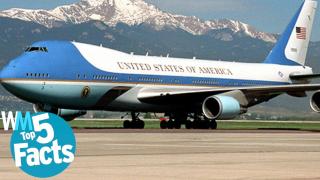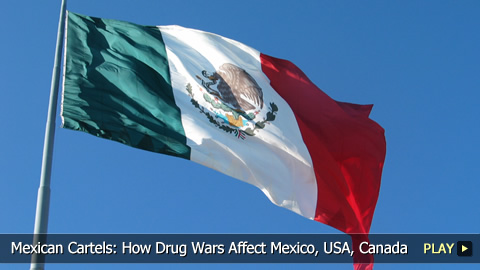Top 10 NAFTA Facts You Should Know

What is NAFTA? The North American Free Trade Agreement went into effect in 1994 as an agreement between the United States, Canada and Mexico. With President Donald Trump talking about pulling out of NAFTA or renegotiating NAFTA, there are some NAFTA facts you should know. After all, there's disagreement about NAFTA's impact on the U.S., Mexico imports a lot of U.S. products and the agreement shifted trade balances. WatchMojo counts down ten fascinating facts about NAFTA.
If you want to have a say in our upcoming topics, be sure to check out our Interactive Suggestion Tool at http://www.WatchMojo.comsuggest
Script written by Craig Butler.
#10: NAFTA Did NOT Originate with Clinton
Nowadays, many people talk as if President Bill Clinton singlehandedly made NAFTA happen. In reality though, talk of a trade agreement between the three North American countries goes back to 1979 when Ronald Reagan announced his presidential candidacy. After the signing of a 1988 free trade agreement between Canada the U.S., Canada made a concerted push for a trilateral agreement in 1991. George H.W. Bush actually signed the pact in 1992– but it was not approved by Congress until Bush left office. Congress passed the agreement in late 1993 during Clinton’s first term, after which it was signed into law and went into effect early the next year – but only after two side agreements were put in place to help protect workers and the environment.
#9: Several Canadian Groups Challenged Part of It
Top 5 Air Force One Facts
Various sections of NAFTA have faced criticism, but Chapter 11 has proven particularly controversial. This is the part which allows a person or a company to sue one of the pact countries when it does something that restricts profits. Opponents of this chapter believe that such legal action can force a country to partake in environmentally or socially destructive practices. Canada has borne the brunt of this, with more than 70% of actions brought against that country. On more than one occasion, Canada has lost and been forced to go against their own environmental policies. As a result, various groups have long denounced chapter 11 as unconstitutional, but to no avail.
#8: Mexico Imports a Lot of U.S. Stuff
Mexican Cartels: How Drug Wars Affect Mexico, USA, Canada
Although many opponents of NAFTA talk about perceived U.S. losses under the agreement, one area where the U.S. has gained is in its exports to the south. According to a 2016 report, Mexico imports more from the U.S. than do the nations that make up the BRIC block. That is to say, Mexico alone is importing more from the U.S. than Brazil, Russia, India and China put together. And it’s across a wide range of products, from agriculture to auto parts. But turnabout is fair play: the U.S. ends up as the target point for 80% of Mexico’s exports.
#7: NAFTA Plays to a Canadian Strength in Jobs
It might go without saying, but international trade is a very important component of the Canadian economy. In fact, it is estimated that about 20% of all Canadian jobs are involved in or related to trade with other countries. The services sector in particular has benefited; over the years since NAFTA began, Canada has gone from importing more high-value services from the U.S. than it exported... to the exact opposite. Furthermore, those employed by the oil industry significantly benefit from the increased exportation of that product to the U.S.
#6: The Agreement Shifted Trade Balances
Top 5 Disturbing Facts About Nazi Experiments
When NAFTA went into effect, everyone knew it would result in significant change - but predicting exactly what those changes would be was difficult. Certainly, many predicted a shift in trade balances – but not everyone knew they would be as dramatic as they have been. For example, in 1993, the U.S.- Mexico trade resulted in a net trade surplus of roughly $5 billion for the United States. In 2014, that had changed into a $54 billion deficit. Conversely the 1993 trade deficit of nearly $3 billion the U.S. ran with Canada turned into a $6 billion surplus in 2015. That’s quite a shift across both borders.
#5: Opponents Were Worried About More Than Jobs
One of the oft-quoted arguments against NAFTA is the potential loss of jobs, but in the lead up to the signing of this agreement, opponents voiced a number of other serious concerns. Beyond job loss, many people worried about possible worker exploitation, pointing to labor conditions in many Mexican factories as being substandard. Beyond human rights, paying less for labor in one country also had the potential to hurt wages in all of the pact nations in order to stay competitive. Many were also anxious about environmental effects, such as increases in pollution brought about by more manufacturing in areas with lax environmental safeguards.
#4: There’s Disagreement About NAFTA’s Impact on the U.S.
Top 5 Apartheid Facts
NAFTA was presented as a way to generate job growth and economic development for all the countries involved, but it’s hard to objectively measure its performance. NAFTA didn’t occur in a vacuum – world events likely affected it in many ways. Critics cite a loss of as many as 750,000 manufacturing jobs, a depression in manufacturing wages and weakened environmental standards. Champions counter with the creation of as many as 5,000,000 jobs, lower prices for consumers and reduced government spending. One study by the Peterson Institute for International Economics reveals a definite benefit – but one that only works out to roughly $400 per person.
#3: Manufacturing Went Down, Wages Went Up
When discussing the impact of NAFTA, there’s often a seesaw effect – one thing goes down while another goes up. That’s definitely the case here. The U.S. had already been experiencing a decline in manufacturing before NAFTA, but that decline significantly accelerated in the years that followed. On the other hand, wages in manufacturing actually went up. From 1994 to 2004, pay for manufacturing jobs increased on average from 34%. So there may have been fewer factory jobs – but those that remained paid better. Ideally, of course, there’d be more jobs AND better-paying jobs – but nobody ever said NAFTA was ideal.
#2: Those Lost Jobs Might Not Have Been NAFTA’s Fault
Top 5 Mind-Bending Facts About Brainwashing
One of the most damning accusations flung against NAFTA involves the loss of all those aforementioned manufacturing jobs. After all, even if jobs are created in other sectors of the economy, that doesn’t necessarily help someone whose training hasn’t prepared them for jobs in those sectors. According to economist Walter Kemmsies however, it’s likely that many of those jobs would have been lost, even if there had been no NAFTA. The emergence of China as a major international economic force – and of its low-priced manufacturing abilities – probably had a greater effect than NAFTA, as did technological advances during the period.
#1: Tariffs Are Not Welcome Under NAFTA
Tariffs are taxes put on goods that are imported into a country, and are typically used to increase sales of homegrown goods. But tariffs are a no-no under NAFTA (and under most free trade agreements). The playing field is supposed to be leveled, and tariffs do the opposite. Because of a pre-existing agreement, there was already tariff-free trade between Canada and the U.S. NAFTA immediately removed about 50% of the tariffs with Mexico, then removed the rest by 2008. Restoration of tariffs is sought by some – but it’s difficult to make work in the NAFTA framework.






